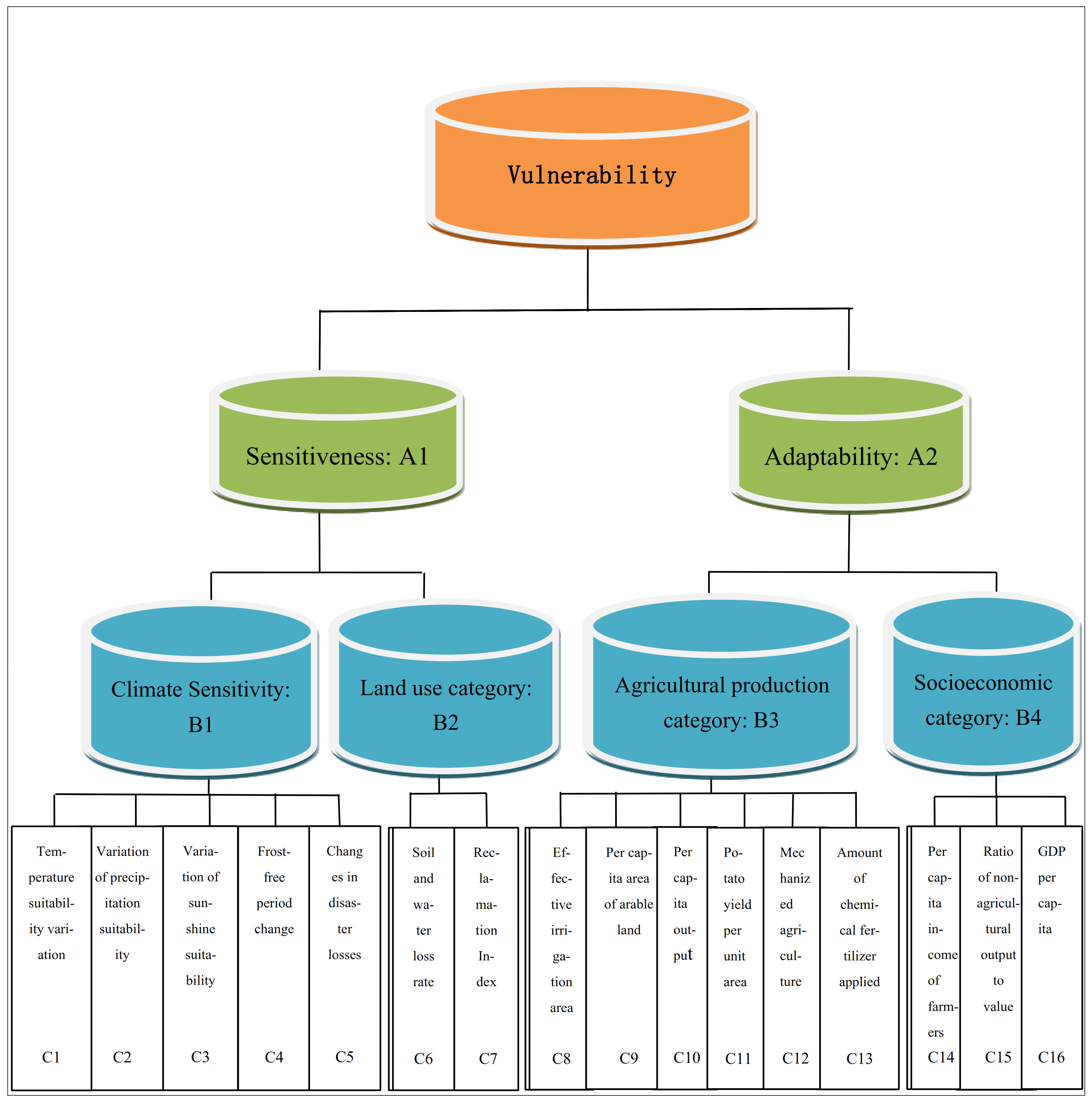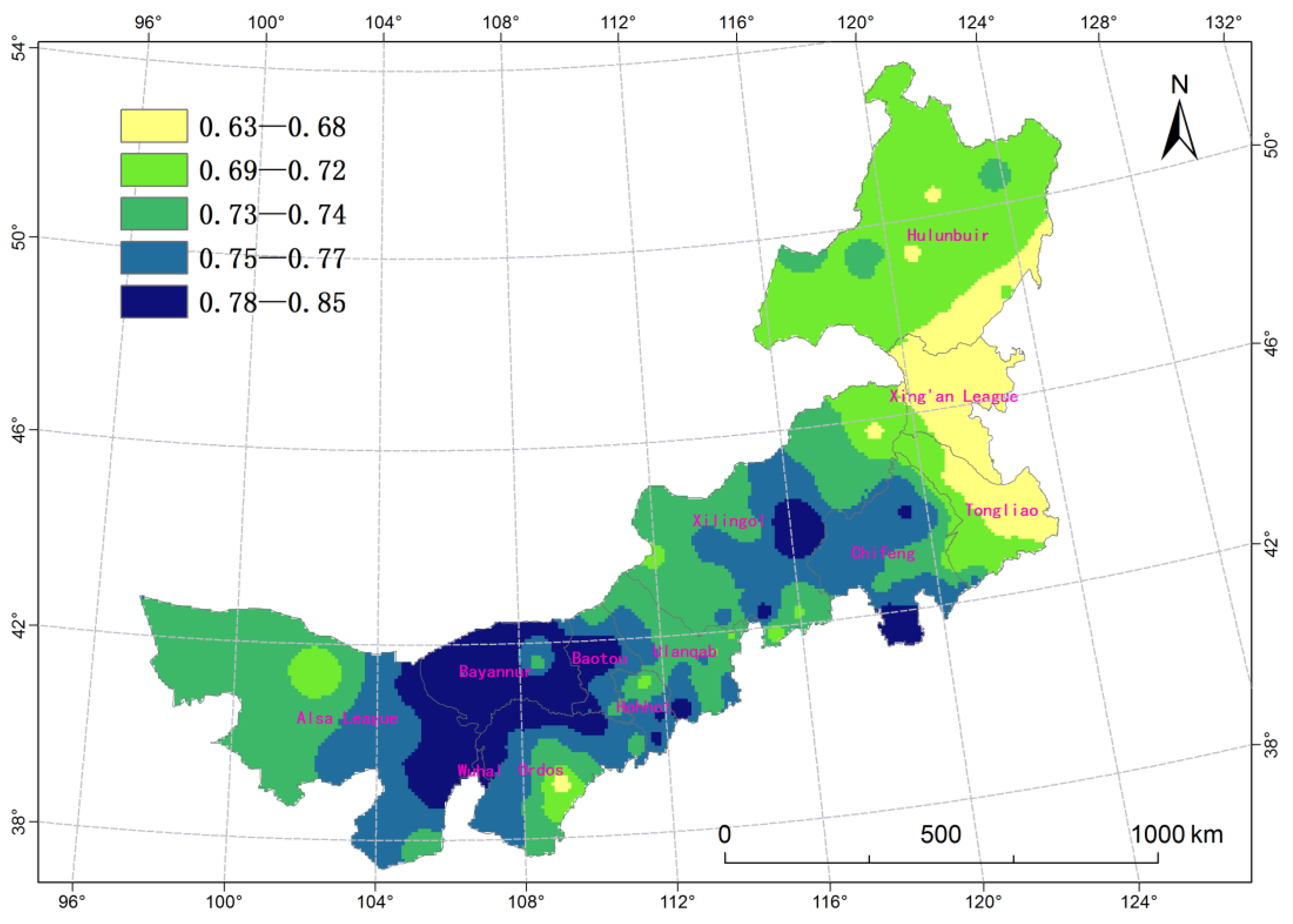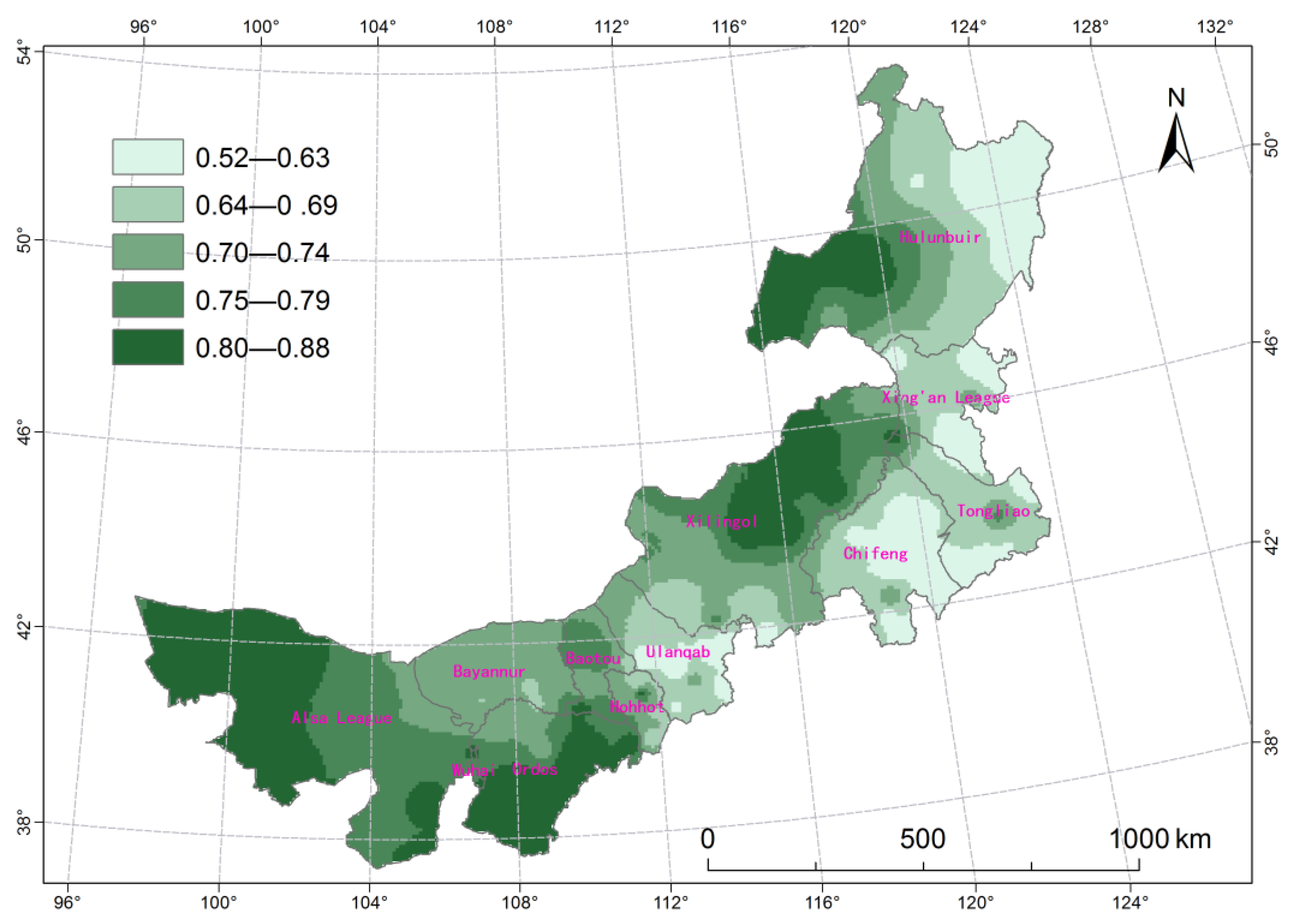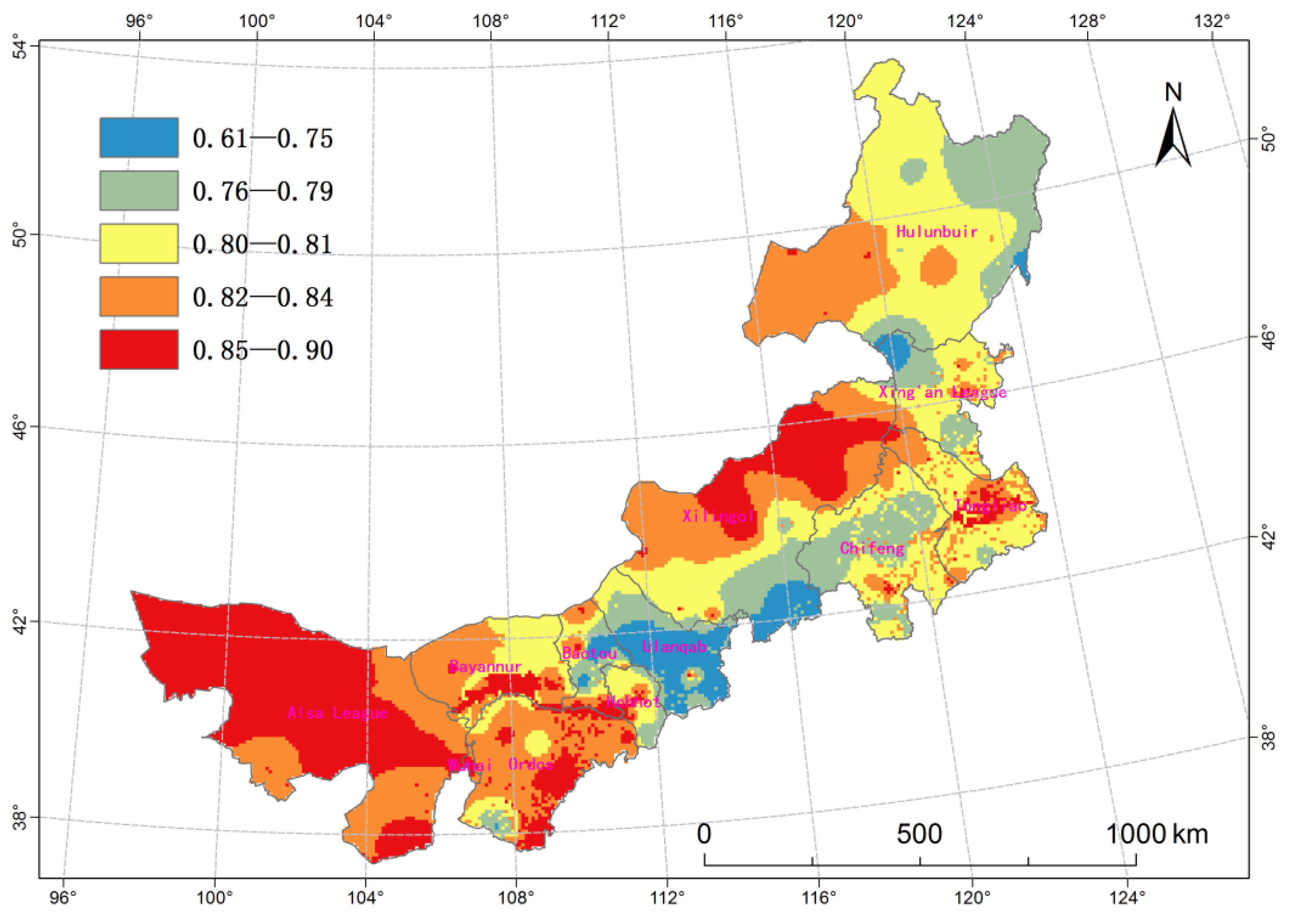Vulnerability Assessment of Potato Growth to Climate Change Based on GIS in Inner Mongolia, China
Abstract
1. Introduction
2. Data
3. Research Methods
3.1. Data Standardization
3.2. Calculation of the Sensitivity and Adaptability-Weighted Comprehensive Evaluation Method
3.3. Vulnerability Index Calculation Ratio Method
4. Construction of the Indicator System
4.1. Description of the Indicator System
4.2. Selection Principles of the Indicators
4.3. Primary Selection and Screening of Indicators
4.4. Connotation of the Evaluation Index
4.5. Determining the Weight of the Evaluation Index
5. Evaluation Result
5.1. Sensitivity Evaluation
5.1.1. Climate Sensitivity Assessment
5.1.2. Evaluation of Land Use Sensitivity
5.1.3. Sensitivity Evaluation
5.2. Evaluation of Adaptability
5.2.1. Evaluation of the Adaptability of Agricultural Production
5.2.2. Evaluation of Socioeconomic Adaptability
5.2.3. Evaluation of Adaptability
5.3. Vulnerability Assessment
6. Discussion
- (1)
- In terms of the research to date, most studies focus on the entire growth period of agricultural ecosystems, with little attention given to the climate vulnerability of crops during each growth period. The different requirements for climate conditions and the temporal distribution of the climate during different growth stages of crops often lead to differences in climate vulnerability during each growth stage. Although the changes in climate suitability for potatoes at different growth stages have been examined in this study, when comprehensively assessing crop climate vulnerability, the entire growth stage was evaluated. In the future, we can continue to conduct separate evaluations at each growth stage.
- (2)
- The vulnerability assessment uses the comprehensive index analysis method, but the existing indicator system is not yet perfect, and construction of an indicator system should be improved in the future. Currently, researchers have mostly constructed indicator systems with two aspects (climate sensitivity and adaptability), but measures to mitigate climate change are gradually receiving attention from governments and scientists around the world. When evaluating agricultural climate vulnerability in the past and predicting short-term vulnerability, it is necessary to construct a more reasonable indicator system with respect to both the sensitivity and adaptability aspects. When predicting long-term agricultural climate vulnerability, it is necessary to consider the ability of society to mitigate climate change.
- (3)
- Due to the severe adverse effects of extreme climate events on agriculture, this study on vulnerability tentatively considers changes in the climate suitability for potatoes and uses its reverse effects to indirectly characterize the adverse effects of extreme climate conditions on potato production. This is a bold attempt to study the impacts of extreme climate events on agriculture, and further research, testing and validation of crop vulnerability impact assessments are needed in the future.
- (4)
- Expert scoring and the Analytic Hierarchy Process (AHP) are often used in determining the weight of indicator systems. Human factors are often involved, which can lead to deviations between research results and reality. To compensate for these shortcomings, artificial neural network models have been introduced and scientific achievements have been made, but there are shortcomings at both the theoretical and applicability levels. Therefore, how to scientifically and reasonably determine weights remains the focus of future exploration [52].
- (5)
- In the future, vulnerability impact assessments should be further tested and verified, and field investigation should be strengthened to accumulate a large number of first-hand observation data and fully supplement the comprehensive impact assessment of potato pests and diseases, such as late blight, powdery scab and black spot.
7. Conclusions
Author Contributions
Funding
Institutional Review Board Statement
Informed Consent Statement
Data Availability Statement
Acknowledgments
Conflicts of Interest
References
- Zhou, W.K. Vulnerability Assessment of agricultural production to climate change in our country. J. Qiqihar Inst. Eng. 2014, 61–66. (In Chinese) [Google Scholar]
- Zheng, Y.F.; Li, H.T.; Wu, R.J. Climate vulnerability of agriculture in our country and its evaluation. J. Agric. Environ. Sci. 2009, 28, 2445–2452. (In Chinese) [Google Scholar]
- Sun, F.; Yang, X. Research progress on agricultural climate change vulnerability assessment. China’s Agrometeorol. 2005, 26, 170–173. (In Chinese) [Google Scholar]
- Deng, K.H.; Ju, H.; Xiong, W. Research progress on the impact of climate change on agriculture in China. Chin. J. Agron. 2006, 439–441. (In Chinese) [Google Scholar]
- Song, J.X. Research progress on agricultural climate change vulnerability and governance. Eco-Economy 2016, 32, 164–168. (In Chinese) [Google Scholar]
- Zhao, J.F.; Guo, J.P.; Jia, M. Exploring the relationships between climatic variables and climate-induced yield of spring maize in Northeast China. Agric. Ecosyst. Environ. 2013, 207, 79–90. [Google Scholar] [CrossRef]
- Zhao, J.F.; Guo, J.P. Possible trajectories of agricultural cropping systems in China from 2011 to 2050. Am. J. Clim. Chang. 2013, 2, 191–197. [Google Scholar] [CrossRef][Green Version]
- Zhao, J.F.; Guo, J.P.; Ma, Y.P.; Wang, P.J. Change trends of China agricultural thermal resources under climate change and related adaptation countermeasures. J. Chin. Appl. Ecol. 2010, 21, 2922–2930. [Google Scholar] [CrossRef]
- Zhao, J.F.; Guo, J.P.; Xu, Y.H.; Mu, J. Effects of climate change on cultivation patterns of spring maize and its climatic suitability in Northeast China. Agric. Ecosyst. Environ. 2015, 202, 178–187. [Google Scholar] [CrossRef]
- Lobell, D.B.; Burke, M.B.; Tebaldi, C.; Mastrandrea, M.D.; Falcon, W.P.; Naylor, R.L. Prioritizing climate change adaptation needs for food security in 2030. Science 2008, 319, 607–610. [Google Scholar] [CrossRef]
- Asseng, S. Rising temperatures reduce global wheat production. Nat. Clim. Chang. 2015, 5, 143–147. [Google Scholar] [CrossRef]
- Lobell, D.B.; Field, C.B. Global scale climate–crop yield relationships and the impacts of recent warming. Environ. Res. Lett. 2007, 2, 014002. [Google Scholar] [CrossRef]
- Lobell, D.B.; Schlenker, W.; Costa-Roberts, J. Climate trends and global crop production since 1980. Science 2011, 333, 616–620. [Google Scholar] [CrossRef] [PubMed]
- Rosenzweig, C.; Elliott, J.; Deryng, D.; Ruane, A.C.; Müller, C.; Arneth, A.; Boote, K.J.; Folberth, C.; Glotter, M.; Khabarov, N.; et al. Assessing agricultural risks of climate change in the 21st century in a global gridded crop model intercomparison. Proc. Natl. Acad. Sci. USA 2014, 111, 3268–3273. [Google Scholar] [CrossRef]
- Wheeler, T.; von Braun, J. Climate change impacts on global food security. Science 2013, 341, 508–513. [Google Scholar] [CrossRef]
- Guo, E.; Zhang, J.; Wang, Y.; Alu, S.; Wang, R.; Li, D.; Ha, S. Assessing nonlinear variation of temperature and precipitation for different growth periods of maize and their impacts on phenology in the Midwest of Jilin Province, China. Theor. Appl. Climatol. 2018, 132, 685–699. [Google Scholar] [CrossRef]
- Yagiz, A.K.; Cakici, M.; Aydogan, N.; Omezli, S.; Yerlikaya, B.A.; Ayten, S.; Maqbool, A.; Haverkort, A.J. Exploration of climate change effects on shifting potato seasons, yields and water use employing NASA and national long-term weather data. Potato Res. 2020, 63, 565–577. [Google Scholar] [CrossRef]
- Hijmans, R.J. The effect of climate change on global potato production. Am. J. Potato Res. 2003, 80, 271–279. [Google Scholar] [CrossRef]
- Albersen, P.; Fischer, G.; Keyzer, M.A.; Sun, L. Estimation of Agricultural Production Relations in the LUC Model for China; International Institute for Applied Systems Analysis Press: Laxenburg, Austria, 2002; 60p. [Google Scholar]
- Dong, Z.Q.; Pan, Z.H.; An, P.L.; Pan, X.B.; Zhao, P.Y. Responses of growth period of spring wheat in north-ern ecotone to climate change: A case of Wuchuan County, Inner Mongolia, China. Progress. Inquisitiones De Mutat. Clim. 2012, 8, 265–271. (In Chinese) [Google Scholar]
- Grassini, P.; Thorburn, J.; Burr, C.; Cassman, K.G. High-yield irrigated maize in the western U.S. Corn Belt. I: On-farm yield, yield potential, and impact of agronomic practices. Field Crops Res. 2011, 120, 142–150. [Google Scholar] [CrossRef]
- Supit, I.; van Diepen, C.A.; de Wit, A.J.W.; Kabat, P.; Baruth, B.; Ludwig, F. Recent changes in the climatic yield potential of various crops in Europe. Agric. Syst. 2010, 103, 683–694. [Google Scholar] [CrossRef]
- Wang, J.; Wang, E.; Yang, X.; Zhang, F.; Yin, H. Increased yield potential of wheat–maize cropping system in the North China Plain by climate change adaptation. Clim. Chang. 2012, 113, 825–840. [Google Scholar] [CrossRef]
- Wang, J.; Wang, E.; Yin, H.; Feng, L.; Zhang, J. Declining yield potential and shrinking yield gaps of maize in the North China Plain. Agric. For. Meteorol. 2014, 195–196, 89–101. [Google Scholar] [CrossRef]
- Wang, J.; Wang, E.; Yin, H.; Feng, L.; Zhao, Y. Differences between observed and calculated solar radiations and their impact on simulated crop yields. Field Crops Res. 2015, 176, 1–10. [Google Scholar] [CrossRef]
- Ju, H.; Xiong, W.; Xu, Y.L.; Lin, E.D. Impacts of climate change on wheat yield in China. Acta Agron. Sin. 2005, 31, 1340–1343. [Google Scholar]
- Pan, G.X.; Gao, M.; Hu, G.H. Impacts of climate change on agricultural production in China. J. Agric. Environ. Sci. 2011, 30, 1698–1706. [Google Scholar]
- Yang, L.T. Risk Zoning of Autunm Frost disaster for potato in Inner Mongolia. Disaster Sci. 2019, 34, 109–113. [Google Scholar] [CrossRef]
- Li, Z.P. Analysis of the present situation and restrictive factors of potato industry in Inner Mongolia. Inn. Mong. 2010, 7–9+14. [Google Scholar]
- IPCC. Climate Change 2014: Impact, Adaptation, and Vulnerability; Cambridge University Press: Cambridge, UK, 2014; Available online: http://www.ipcc.ch/report/ar5/wg2/ (accessed on 1 July 2023).
- IPCC. Climate Change 2013: The Physical Science Basis; Cambridge University Press: Cambridge, UK, 2013. [Google Scholar]
- IPCC. Climate Change 2007: Impacts, Adaptation, and Vulnerability; Cambridge University Press: Cambridge, UK, 2007; pp. 1–976. [Google Scholar]
- IPCC. Climate Change 2001: Impacts, Adaptation, and Vulnerability; Cambridge University Press: Cambridge, UK, 2001; pp. 1–1032. [Google Scholar]
- Malhi, G.S.; Kaur, M.; Kaushik, P. Impact of Climate Changeon Agriculture and Its Mitigation Strategies: A Review. Sustainability 2021, 13, 1318. [Google Scholar] [CrossRef]
- Wang, J.; Han, Y.X.; Wei, Y.M. Climate vulnerability of autumn grain crops in rainfed farming areas of Gansu Province. Agric. Res. Arid. Areas 2006, 24, 15–19. [Google Scholar]
- Duan, X.W.; Xie, Y.; Liu, G.; Lin, T. Analysis of vulnerability of grain crop yields to impacts of climate change in Heilongjiang Province. Acta Agron. Sin. 2008, 29, 6–11. [Google Scholar]
- Lin, E.D.; Wu, S.H.; Dai, X.S.; Liu, H.B.; Liu, C.Z.; Gao, Q.X.; Li, C.X.; Bao, M.Z. Recent understanding of the impact of climate change. Adv. Clim. Chang. Res. 2007, 3, 125–131. [Google Scholar]
- Wang, F.T.; Liu, W.Q. Analysis on vulnerability of agro-production to climate change in the loess plateau. J. Nanjing Inst. Meteorol. 2003, 8, 91–100. [Google Scholar]
- Zhao, Y.X.; He, L.; Liu, S.D.; Liu, W.Q.; He, Y.; Zhang, J.P. Evaluation method of agro-ecosystem vulnerability. Chin. J. Ecol. 2007, 26, 754–758. [Google Scholar]
- Kropp, J.P.; Block, A.; Reusswig, F.; Zickfeld, K.; Schellnhuber, H.J. Semiquantitative assessment of regional climate vulnerability: The North-Rhine Westphalia study. Clim. Chang. 2006, 76, 265–290. [Google Scholar] [CrossRef]
- Yao, Y.B.; Wang, R.Y.; Zhao, H.; Wang, D.J. Effects of climate change at different elevations on potato growth vulnerability in Loess Plateau of Gansu Province. Agric. Res. Arid. Areas 2013, 31, 52–58. (In Chinese) [Google Scholar]
- Tao, S.C.; Xu, Y.L.; Liu, K.; Pan, J.; Gou, S.W. Vulnerability of agriculture to climate change. Adv. Clim. Chang. Res. 2011, 7, 143–148. (In Chinese) [Google Scholar]
- Xie, L.Y.; Li, Y.; Qian, F.K.; Zhao, H.L.; Han, X. Response of food production system to climate change: Sensitivity and vulnerability. China Popul. Resour. Environ. 2014, 24, 25–30. (In Chinese) [Google Scholar] [CrossRef]
- Sun, F.; Lin, E.D.; Li, J.P.; Xiong, W. Adaptation strategy of potato production in Ningxia based on DSSAT model. Chin. J. Agrometeorol. 2008, 29, 127–129+133. [Google Scholar]
- Lin, E.D.; Wang, J.H. Sensitivity and vulnerability of Chinese agriculture to global warming. Rural Ecol. Environ. 1994, 10, 1–5. [Google Scholar]
- Liu, W.Q.; Wang, F.T. In loess plateau area of agricultural production to climate change vulnerability analysis. J. Nanjing Inst. Meteorol. 2002, 25, 620–624. [Google Scholar]
- He, L. Study on the Impact of Climate Change on Agricultural Production Vulnerability in the Northern Agro-Pastoral Ecotone. Ph.D. Thesis, Nanjing University of Information Science and Technology, Nanjing, China, 2007. [Google Scholar]
- Tang, W.A. Vulnerability Assessment of Regional Agriculture to Climate Change: A Case Study of Ningxia. Ph.D. Thesis, Chinese Academy of Agricultural Sciences, Beijing, China, 2007. [Google Scholar]
- Liu, J. Vulnerability Assessment of Food Production to Climate Change in Jiangxi Province. Ph.D. Thesis, Jiangxi Agricultural University, Nanchang, China, 2013. [Google Scholar]
- Song, Q.H.; Qian, H.S.; Lai, C.J. Research progress on Vulnerability Assessment of agricultural climate change. Anhui Agric. Sci. 2008, 9646–9649. (In Chinese) [Google Scholar] [CrossRef]
- Sun, F.; Yang, X.; Lin, E.D. Sensitivity and vulnerability of maize to climate change in our country. Reg. Res. Dev. 2005, 24, 54–57. (In Chinese) [Google Scholar]
- Sun, F.; Yang, X.; Lin, E.D. Sensitivity and vulnerability of rice to climate change in our country. J. Nat. Disasters 2004, 13, 85–89. (In Chinese) [Google Scholar]
- Sun, F.; Yang, X.; Lin, E.D. Sensitivity and vulnerability of wheat to climate change in China. Chin. Agric. Sci. 2005, 38, 692–696. (In Chinese) [Google Scholar]
- Dong, Z.Q. Vulnerability and Risk Assessment of Spring Wheat Production in Semiarid Region under the Background of Climate Change. Ph.D. Thesis, China Agricultural University, Beijing, China, 2016. (In Chinese). [Google Scholar]
- Zheng, J.Y.; Huang, J.H. The evaluation of grain disaster damage in our country in recent 40 years. J. Geogr. 1998, 3–5. (In Chinese) [Google Scholar]
- He, Y.N.; Yang, F. Study on background value of environmental soil organic matter in Inner Mongolia Autonomous Region. Inn. Mong. Environ. Prot. 1996, 8, 40–41. (In Chinese) [Google Scholar]
- Xu, S.P.; Tao, S.; Cao, J. Spatial structure characteristics of soil pH value, clay and organic matter content in Inner Mongolia. Soil Bull. 2001, 32, 145–148. (In Chinese) [Google Scholar] [CrossRef]
- Zhang, Y.M.; Liu, Y. Change trend and prediction of cultivated land soil nutrients in Inner Mongolia. Inn. Mong. Agric. Sci. Technol. 2004, 45–46. (In Chinese) [Google Scholar]
- Yang, L.T.; Zhao, J.F.; Wang, S.; Li, L.H.; Xie, H.F. Effects of Climate Change on the Climatic Production Potential of Potatoes in Inner Mongolia, China. J. Sustainability 2022, 14, 7836. [Google Scholar] [CrossRef]
- Li, K.R.; Cao, M.K.; Yu, L. Vulnerability Assessment of China’s natural ecosystems to climate change. Geogr. Stud. 2005, 24, 653–663. (In Chinese) [Google Scholar]
- Liu, Z.Q.; Liu, H.Y.; Lu, X.G. Study on ecological vulnerability of wetland in Sanjiang Plain. J. Appl. Ecol. 2001, 12, 241–244. (In Chinese) [Google Scholar]
- Qin, X.W.; Zhang, S.Q.; Li, X.F. Ecological vulnerability assessment of Zhalong waterfowl habitat. Agric. Syst. Sci. Integr. Res. 2009, 25, 147–150+157. (In Chinese) [Google Scholar]
- Donatti, C.I.; Harvey, C.A.; Martinez-Rodriguez, M.R.; Vignola, R.; Rodriguez, C.M. Vulnerability of smallholder farmers to climate change in Central America and Mexico: Current knowledge and research gaps. Clim. Dev. 2019, 11, 264–286. [Google Scholar] [CrossRef]
- Parker, L.; Bourgoin, C.; Martinez-Valle, A.; Läderach, P. Vulnerability of the agricultural sector to climate change: The development of a pantropical Climate Risk Vulnerability Assessment to inform subnational decision-making. PLoS ONE 2019, 14, e0213641. [Google Scholar] [CrossRef] [PubMed]









| RSI/RAI. | Level 1 Indicators | Level 1 Weight | Secondary Indicators | Unit | Secondary Weight | Total Weight |
|---|---|---|---|---|---|---|
| Sensitivity A1 | Climate Sensitivity B1 | 0.80 | Temperature suitability variation (C1, Negative) | Dimensionless | 0.30 | 0.24 |
| Variation of precipitation suitability (C2, Negative) | Dimensionless | 0.40 | 0.32 | |||
| Variation of sunshine suitability (C3, Negative) | Dimensionless | 0.15 | 0.12 | |||
| Frost-free period change (C4) | Dimensionless | 0.10 | 0.08 | |||
| Changes in disaster losses (C5) | Dimensionless | 0.05 | 0.04 | |||
| Land use category B2 | 0.20 | Soil and water loss rate (C6) | Percentage | 0.30 | 0.06 | |
| Reclamation Index (C7) | Percentage | 0.70 | 0.14 | |||
| Adaptability A2 | Agricultural production category B3 | 0.67 | Effective irrigation area ratio (C8) | Percentage | 0.10 | 0.07 |
| Per capita area of arable land (C9, Negative) | hm2/People | 0.35 | 0.23 | |||
| Per capita grain output (C10, Negative) | kg/People | 0.25 | 0.17 | |||
| Yield per unit area (C11, Negative) | kg/hm2 | 0.15 | 0.10 | |||
| Mechanized agriculture (C12) | Wkw | 0.10 | 0.07 | |||
| Amount of chemical fertilizer applied (C13) | t | 0.05 | 0.03 | |||
| Socioeconomic category B4 | 0.33 | Per capita income of farmers (C14) | Yuan/People | 0.42 | 0.14 | |
| Ratio of nonagricultural output to value (C15) | % | 0.36 | 0.12 | |||
| GDP per capita (C16) | Yuan/People | 0.22 | 0.07 |
Disclaimer/Publisher’s Note: The statements, opinions and data contained in all publications are solely those of the individual author(s) and contributor(s) and not of MDPI and/or the editor(s). MDPI and/or the editor(s) disclaim responsibility for any injury to people or property resulting from any ideas, methods, instructions or products referred to in the content. |
© 2023 by the authors. Licensee MDPI, Basel, Switzerland. This article is an open access article distributed under the terms and conditions of the Creative Commons Attribution (CC BY) license (https://creativecommons.org/licenses/by/4.0/).
Share and Cite
Yang, L.-T.; Sun, Y.-G.; Jiang, C.; Zhao, J.-F.; Qian, J.-X. Vulnerability Assessment of Potato Growth to Climate Change Based on GIS in Inner Mongolia, China. Sustainability 2023, 15, 14607. https://doi.org/10.3390/su151914607
Yang L-T, Sun Y-G, Jiang C, Zhao J-F, Qian J-X. Vulnerability Assessment of Potato Growth to Climate Change Based on GIS in Inner Mongolia, China. Sustainability. 2023; 15(19):14607. https://doi.org/10.3390/su151914607
Chicago/Turabian StyleYang, Li-Tao, Yong-Gang Sun, Chuan Jiang, Jun-Fang Zhao, and Jin-Xia Qian. 2023. "Vulnerability Assessment of Potato Growth to Climate Change Based on GIS in Inner Mongolia, China" Sustainability 15, no. 19: 14607. https://doi.org/10.3390/su151914607
APA StyleYang, L.-T., Sun, Y.-G., Jiang, C., Zhao, J.-F., & Qian, J.-X. (2023). Vulnerability Assessment of Potato Growth to Climate Change Based on GIS in Inner Mongolia, China. Sustainability, 15(19), 14607. https://doi.org/10.3390/su151914607









